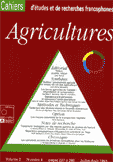Détermination du traitement mutagène optimal des graines de haricot commun ("Phaseolus vulgaris" L. cv. Rubona 5) exposées à un rayonnement gamma
Résumé
Seeds of the bean, Phaseolus vulgaris L. cv. Rubona 5, were irradiated with cesium 137 in order to estimate the optimum working radiation dose range. Germination rate, seedling height, lenght of hypocotyl and epicotyl, primary leaf area, and weight (fresh and dry) were evaluated. The data indicated that germination was not inhibited up to 150 grays (Gy). Above this dose, inhibition was observed. Seedling height and primary leaf area indicated that irradiation had a stimulating-effect at low doses when trial plants were compared to controls. The optimum stimulating-effect occurred at 75 Gy, and decreased as radiation increased. The most sensitive parameter was epicotyl length. ED 30 was calculated to reach approximately 240 to 280 Gy.Téléchargements
Publié
1993-07-01
Comment citer
Kalonji-Mbuyi, A. ., Tshivuila Tshyanyanga, D. ., Umba di Umba, B. ., Kembola Kejuni, T. ., & Nsumbu Nlandu, P. . (1993). Détermination du traitement mutagène optimal des graines de haricot commun ("Phaseolus vulgaris" L. cv. Rubona 5) exposées à un rayonnement gamma. Cahiers Agricultures, 2(4), 277–279 (1). Consulté à l’adresse https://revues.cirad.fr/index.php/cahiers-agricultures/article/view/29798
Numéro
Rubrique
Articles

